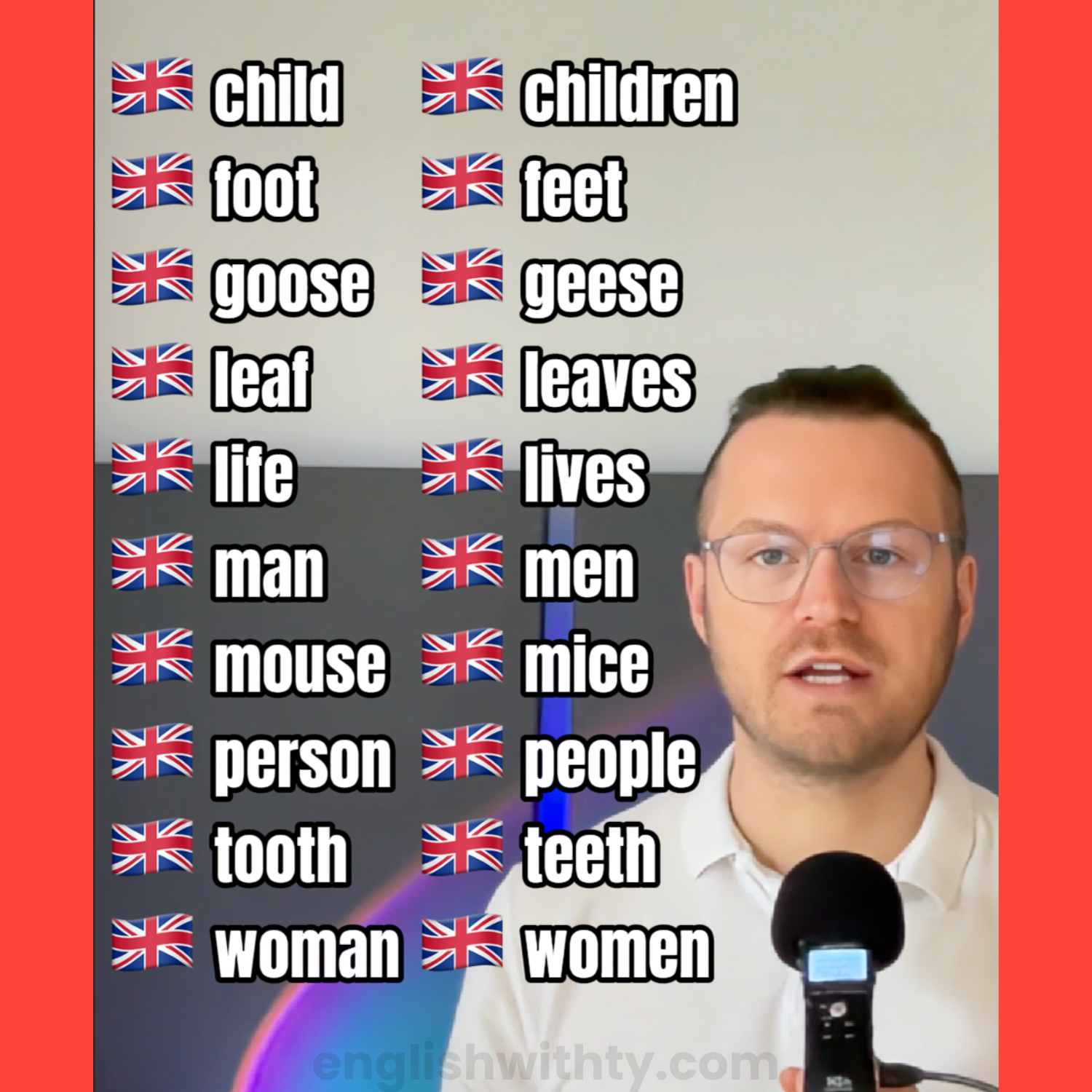The English language can often seem complicated, especially when it comes to irregular plural forms. While most nouns simply take an “s” to form the plural, there are some tricky exceptions. Words like child and children or man and men often pose challenges for language learners.
In this article, we explain irregular plural forms in English in a simple and easy-to-understand way. Whether you’re a beginner or an advanced learner, this blog post should help you master the most common exceptions.
We also offer helpful interactive flashcards and a downloadable PDF so you can put your knowledge into practice right away. Let’s overcome the hurdles of these special plural forms together and take your English to the next level!
Free PDF with the Most Important Irregular Plural Forms in English

Irregular plural forms in English can be a real challenge. To help you overcome this hurdle, we’re offering a free PDF for you to download. This document is designed to give you a clear overview of the most common irregular plural forms.
Another advantage of our PDF is the fact that you can download and print it easily. This way, you can practise anytime and anywhere, without needing an internet connection. Whether you’re on your way to work or studying quietly at home, our PDF gives you the right material at your fingertips. Don’t let irregular plural forms intimidate you! Use our PDF as a learning tool to improve your English.
Table with Common English Irregular Plural Forms
The English language is known for its exceptions and special cases, and irregular plural forms are a prime example. Some of the most common irregular plurals are child – children, man – men, and woman – women. These words can be especially hard to remember because they don’t follow the regular plural rule of simply adding an “s.” Instead, they often change their vowel or take on a completely different form, making them particularly challenging for some language learners to master.
Here is a table with the most important irregular plural forms:
| Singular 🇬🇧 | Plural 🇬🇧 |
|---|---|
| Child | Children |
| Foot | Feet |
| Goose | Geese |
| Leaf | Leaves |
| Life | Lives |
| Man | Men |
| Mouse | Mice |
| Person | People* |
| Tooth | Teeth |
| Woman | Women |
*“People” is the standard plural of “person” and is used almost always.
👉 There are many people at the party.
*“Persons” can also be used but only in formal or legal contexts.
👉 Missing persons report
👉 Authorised persons only
Video with Common English Irregular Plural Forms
It’s important to get familiar with these exceptions and practise them regularly to use them correctly. The best way to learn these plural forms is through constant repetition and applying them in different contexts. So, watch the video several times and repeat after me to learn the most important irregular plural forms in English quickly and easily. Then test your knowledge with the interactive flashcards below the video ⬇️
Flashcards with Common English Irregular Plural Forms
Find-The-Words-Game with Common English Irregular Plural Forms
Rules and Exceptions for Irregular Plural Forms
The rules for irregular plural forms in English aren’t always easy to figure out. While most nouns simply form the plural by adding an “s,” there is no single rule for irregular forms. Instead, these plurals are often based on historical or linguistic peculiarities. However, having a basic understanding of these exceptions can help you use the plural forms correctly.
English also has many words with silent letters. I’ve written an article and created a video course about that as well:

A typical example of a rule that is often broken is the vowel change in the word stem, as seen in man – men or woman – women. These changes are historically based and come from older versions of the English language. Another common pattern is the change of the final letter, as with leaf – leaves or life – lives. In this cases, the ending “f” changes to “ves” in the plural version.
Despite these rules, there are also words that seem to defy any logic. One example is sheep, which remains the same in both singular and plural. Such words are especially challenging because they don’t undergo any visible change and can only be used correctly through context or experience. These exceptions require a certain amount of memorisation and practice to master them properly in everyday language. For some types of learners, I would also recommend writing them down. For this, I’d recommend these* vocabulary flashcards.
Tips for Using Irregular Plural Forms Correctly
Irregular plural forms can be a stumbling block even for advanced English learners. A key tip for dealing with them is to regularly read and listen to English texts where these forms appear. This helps you internalize the correct usage in a natural context. Reading books, newspapers, or listening to podcasts and watching movies in English can help you learn irregular plural forms in an intuitive way. You can check out the 20 best series for learning English right here.
Another effective method is keeping a vocabulary notebook* where you write down the irregular plural forms you come across. Update this list regularly and try to use the words in your own sentences. Actively writing and speaking with these words strengthens your understanding and helps you recall the correct forms more quickly.
Finally, using exercises and quizzes is a great way to test and deepen your knowledge. There are many online platforms and apps specifically designed to help you learn irregular plural forms. Use these resources to regularly review and expand your knowledge. This way, you’ll gradually internalize the exceptions and be able to use them confidently in conversation. I highly recommend Preply* for this purpose.
How to Learn Irregular Plural Forms
To learn irregular plural forms effectively, targeted practice is essential. That’s why I’ve included the video and flashcards in this article. I recommend watching the video several times and to use the flashcards above. For some learning types, it also makes sense to write them down again in a vocabulary notebook or on flashcards. You can find these and other helpful products right here.
Another useful exercise format is multiple-choice questions that require you to choose between several possible plural forms. These exercises challenge you to recall your knowledge and check whether you can correctly identify the irregular forms. This type of question can also be used in group or partner activities to encourage interactive learning.
Finally, writing exercises can also help solidify what you’ve learned. Try writing short stories or dialogues where you deliberately use irregular plural forms. Writing forces you to actively apply the forms and get creative with the language. By practising regularly in different formats, using irregular plural forms correctly becomes a habit and greatly boosts your language confidence.
These kinds of exercises can be done with an AI – here’s an example. However, I would still recommend private lessons with an expert, for instance on Preply.
How can you learn English most effectively? You can read a comprehensive guide to effective language learning right here.
Conclusion
Irregular plural forms in English are one of the many challenges language learners face. By understanding the most common irregular forms and their exceptions, you can significantly improve your English. Knowing the rules behind these exceptions and practising regularly are key to using these plural forms correctly. Our free PDF provides you with a valuable resource to deepen and apply this knowledge.
Key points include recognising the most common irregular plural forms such as children, men, women, and mice. Additionally, it’s important to understand the various rules and exceptions that influence these forms and to be aware of common mistakes. Regular practice and using these forms in different contexts are essential for confident and accurate language use.
In conclusion, we encourage you to use the provided resources and exercises to continuously expand your knowledge. Learning irregular plural forms can be challenging, but with the right tools and techniques, it is absolutely achievable. By following the strategies mentioned and making the best use of the resources, you can take your English to the next level and avoid misunderstandings. Good luck!
Did you find the article helpful? Then you might really like the platform Preply. You can find over 50,000 top private tutors who can teach you privately in more than 120 languages. You can sign up and book a meeting with Ty or another tutor. Using our link, you’ll even get a 50% discount for your first lesson!

This post contains affiliate links. If you purchase something through one of these links, I receive a small commission at no extra cost to you. Thank you very much for your support!




